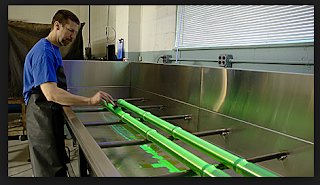 Formulation of liquid penetrant is a complex process because of the numerous and frequent conflicting requirements. High on the list of requirements is the ability to enter or penetrate and fill voids that contain tight or small surface openings. This conflicts with the need to be able to remove the excess surface penetrant. Another requirement of equal importance is the visibility or contrast between the indication and the surface background. Dye added to the penetrant solution helps to provide the necessary contrast between the indication and the surface background.
Formulation of liquid penetrant is a complex process because of the numerous and frequent conflicting requirements. High on the list of requirements is the ability to enter or penetrate and fill voids that contain tight or small surface openings. This conflicts with the need to be able to remove the excess surface penetrant. Another requirement of equal importance is the visibility or contrast between the indication and the surface background. Dye added to the penetrant solution helps to provide the necessary contrast between the indication and the surface background.To accept the dye into the penetrant solution, the penetrant must have a high solvent ability. This tends to conflict with the requirement of a high flash point, 93º Celsius (200ºF), to permit its use in open tanks and relatively low evaporation rate for longtime storage in open tanks.
Unfortunately, there is neither a fixed rule for formulating a liquid penetrant nor a set of criteria that will provide a satisfactory product. However, there are some fundamental prerequisites that are necessary for acceptable performance. The penetrant must:
- be capable of smoothly and evenly disturbing itself over the surface of the part to be tested- it must be able to wet the surfaces of the more common metals;
- be capable of entering and filling surface openings even though they may be very small;
- resist removal and remain in discontinuities during removal of excess penetrant on the surface of the part;
- be capable of exiting surface penetrant has been removed;
- have high visibility or contrast in small quantities or thin films when viewed on the part surface;
- not each, corrode or otherwise degrade part and;
- be nontoxic.
